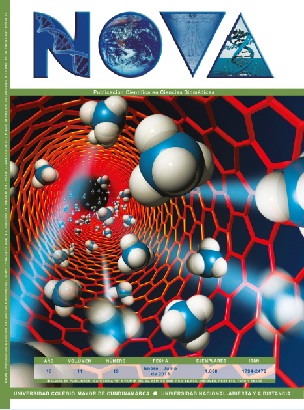NOVA por http://www.unicolmayor.edu.co/publicaciones/index.php/nova se distribuye bajo una licencia Reconocimiento No Comercial- Compartir igual
Así mismo, los autores mantienen sus derechos de propiedad intelectual sobre los artículos,
Declaración de privacidad.
Los nombres y las direcciones de correo electrónico introducidos en esta revista se usarán exclusivamente para los fines establecidos en ella y no se proporcionarán a terceros o para su uso con otros fines.
Comparative study of the international significant standards for the definition, exclusion, declassification and identification of hazardous wastes
In this article the international important standards of hazardous wastes are compared including definition, exclusion, declassification and identification.
Some of the main hazardous wastes classification systems are: Basel convention about the control of cross-border movement of hazardous waste and its elimination, the European list of wastes (LER) and the U.S code of federal regulations 40 CFR 261. The three standards have big differences regarding the classification criteria and identification of hazardous waste therefore about their own classification lists. For this reason, this article aims to make a critical and comparative analysis between the three regulations to analyze the advantages and disadvantages in regard to different aspects related to this problematic (definition, exclusion, declassification and identification of hazardous wastes).
Decreto 27000MINAE, reglamento sobre las características y el listado sobre los desechos peligrosos. Diario Oficial del Gobierno de Costa Rica, (29 de Junio de 1998).
Norma Oficial Mexicana NOM-052-SEMARNAT-2005, Que establece las características, el procedimiento de identificación, clasificación y los listados de los residuos peligrosos.
Diario Oficial de la Federación. DOF: 23/06/2006, (23 de Junio de 2006).
Decreto No. 831/1993, reglamentación de la Ley 24051 de residuos peligrosos. Boletín Oficial de la Republica de Argentina, Número 27.630, (03 de mayo de 1993).
Decreto 4741 de 2005, por el cual se reglamenta parcialmente la prevención y el manejo de los residuos o desechos peligrosos generados en el marco de la gestión integral. Diario Oficial de la Republica de Colombia, Número 46.137, (30 de diciembre de 2005).
Riechmann, J. Biomímesis, ensayos sobre imitación de la naturaleza, ecosocialismo y autocontención. Madrid, España: Catarata; 2006.
Cheremisinoff, N. P. Handbook of Solid Waste Management and Waste Minimization Technologies. United States of America: Butterworth Heinemann; 2002.
El-Haggar, S. Sustainable Industrial Design and Waste Management. Cairo, Egypt: Elsevier Ltd; 2007
Ministerio del Medio Ambiente (Colombia). Política para la gestión integral de residuos. Ministerio de Ambiente; 1997.
Ministerio de Ambiente, Vivienda y Desarrollo Territorial (Colombia). Politica ambiental para la gestión integral de residuos o desechos peligrosos; Ministerio de Ambiente; 2005.
Ministerio de Ambiente Vivienda y Desarrollo Territorial (Colombia). Gestión integral de residuos o desechos peligrosos, bases conceptuales. Ministerio de Ambiente Vivienda y Desarrollo Territorial; 2007.
Martínez, J. Guía para la Gestión Integral de Residuos Peligrosos. Montevideo, Uruguay: Centro Coordinador del Convenio de Basilea para América Latina y el Caribe; 2005.
Organización de las Naciones Unidas ONU. Convenio de Basilea sobre el control de los movimientos transfronterizos de los desechos peligrosos y su eliminación. Programa de las Naciones Unidas para el Medio Ambiente UNEP; 1989.
Directiva del Consejo 75/442/CEE, relativa a los residuos (con las modificaciones de la Directiva del Consejo 91/156/CEE de 18 de marzo de 1991). Diario Oficial de las Comunidades
Europeas, Número 15 vol 01, (15 de julio de 1975).
Directiva del Consejo 91/156/CEE, por la que se modifica la Directiva 75/442/CEE relativa a los residuos. Diario Oficial de las Comunidades Europeas, Número L 78/32, (18 de marzo de 1991).
Directiva del Consejo 91/689/CEE, relativa a residuos peligrosos. Diario Oficial de las Comunidades Europeas, Número L 377/20, (12 de Diciembre de 1991).
Decisión de la Comisión 94/3/CE, por la que se establece el procedimiento de notificación de interceptación de envíos u organismos nocivos procedentes de terceros países que presenten
un peligro fitosanitario inminente. Diario Oficial de las Comunidades Europeas, Número L 5/15, (5 de febrero de 1994).
Directiva del Consejo 94/31/CE, Por la que se modifica la Directiva 91/689/CEE relativa a los residuos peligrosos. Diario Oficial de las Comunidades Europeas, Número L 168/28, (27
de junio de 1994).
Reglamento de la Comisión 96/350/CE, por la que se adaptan los Anexos II A y II B de la Directiva 75/442/CEE del Consejo relativa a los residuos. Diario Oficial de las Comunidades Europeas, Número L 135/32, (24 de mayo de 1996).
Directiva del Parlamento Europeo y del Consejo 1999/45/CE, sobre la aproximación de las disposiciones legales, reglamentarias y administrativas de los Estados miembros relativas a la
clasificación, el envasado y el etiquetado de preparados peligrosos, Diario Oficial de las Comunidades Europeas, Número L 200/1, (31 de mayo de 1999).
Directiva del Parlamento Europeo y del Consejo 2006/12/CE, relativa a los residuos. Diario Oficial de las Comunidades Europeas, Número L 114/9, (5 de abril de 2006).
Directiva del Parlamento Europeo y del Consejo 2008/98/CE, sobre los residuos y por la que se deroga determinadas Directivas. Diario Oficial de las Comunidades Europeas, Número L
/3, (19 de Noviembre de 2008).
Reglamento del Consejo 259/93, relativo a la vigilancia y al control de los traslados de residuos en el interior, a la entrada y a la salida de la Comunidad Europea. Diario Oficial de las Comunidades Europeas, Número L 30/01, (01 de febrero de 1993).
Decisión del Consejo 94/904/CE, por la que se establece una lista de residuos peligrosos en virtud del artículo 1, apartado 4, de la Directiva 91/689/CEE. Diario Oficial de las Comunidades
Europeas, Número L 356/14, (22 de diciembre de 1994).
Decisión de la Comisión 2000/532/CE, que sustituye a la Decisión 94/3/CE por la que se establece una lista de residuos de conformidad con la letra a) del artículo 1 de la Directiva
/442/CEE del Consejo relativa a los residuos y a la Decisión 94/904/CE del Consejo por la que se establece una lista de residuos peligrosos en virtud del apartado 4 del artículo 1 de la
Directiva 91/689/CEE del Consejo relativa a los residuos peligrosos. Diario Oficial de las Comunidades Europeas, Número L 226/3, (3 de mayo de 2000).
Decisión de la Comisión 2001/118/CE, por la que se modifica la Decisión 2000/532/CE en lo que se refiere a la lista de residuos. Diario Oficial de las Comunidades Europeas, Número L
/1, (16 de enero de 2001).
Decisión de la Comisión 2001/119/CE, que modifica la Decisión 2000/532/CE que sustituye a la Decisión 94/3/CE por la que se establece una lista de residuos de conformidad con la
letra a) del artículo 1 de la Directiva 75/442/CEE del Consejo relativa a los residuos y a la Decisión 94/904/CE del Consejo por la que se establece una lista de residuos peligrosos en
virtud del apartado 4 del artículo 1 de la Directiva 91/689/CEE del Consejo relativa a los residuos peligrosos. Diario Oficial de las Comunidades Europeas, Número L 47/32, (22
de enero de 2001).
CFR 261.2 Definition of solid waste. Code of Federal Regulations, Class Number AE 2.106/3:40/, (01-07-2012).
CFR 261.3 Definition of hazardous waste. Code of Federal Regulations, Class Number AE 2.106/3:40/, (01-07-2012).
CFR 261.4 Exclusions. Code of Federal Regulations, Class Number AE 2.106/3:40/, (01-07-2012).
CFR 261.10 Criteria for identifying the character- istics of hazardous waste. Code of Federal Regulations, Class Number AE 2.106/3:40/, (01-07-2012).
CFR 261.11 Criteria for listing hazardous waste. Code of Federal Regulations, Class Number AE 2.106/3:40/, (01-07-2012).
CFR 261.21 Characteristic of ignitability. Code of Federal Regulations, Class Number AE 2.106/3:40/, (01-07-2012).
CFR 261.22 Characteristic of corrosivity. Code of Federal Regulations, Class Number AE 2.106/3:40/, (01-07-2012).
CFR 261.23 Characteristic of reactivity. Code of Federal Regulations, Class Number AE 2.106/3:40/, (01-07-2012).
CFR 261.24 Toxicity characteristic . Code of Federal Regulations, Class Number AE 2.106/3:40/, (01-07-2012).
FR 261.31 Hazardous wastes from non-specific sources. Code of Federal Regulations, Class Number AE 2.106/3:40/, (01-07-2012).
FR 261.32 Hazardous wastes from specific sources. Code of Federal Regulations, Class Number AE 2.106/3:40/, (01-07-2012).
FR 261.33 Discarded commercial chemical products, off specification species, container residues, and spill residues thereof. Code of Federal Regulations, Class Number AE 2.106/3:40/, (01-07-2012).
Enviromental Protection Agency EPA (sede Web). U.S: EPA; (actualizado 15 de noviembre de 2012; acceso 14 de julio de 2013). Method 1110A. Corrosivity Toward Steel; (6 páginas).
Disponible en: http://www.epa.gov/osw/hazard/testmethods/sw846/pdfs/1110a.pdf
Enviromental Protection Agency EPA (sede Web). U.S: EPA; (actualizado 15 de noviembre de 2012; acceso 14 de julio de 2013). Method 1311. Toxicity Characteristic Leaching Procedure;
(35 páginas). Disponible en: http://www.epa.gov/osw/hazard/testmethods/sw846/pdfs/1311.pdf
Enviromental Protection Agency EPA (sede Web). U.S: EPA; (actualizado 15 de noviembre de 2012; acceso 14 de julio de 2013). Method 9040C pH Electrometric Measurement; (5
páginas). Disponible en: http://www.epa.gov/osw/hazard/testmethods/sw846/pdfs/9040c.pdf
The National Association of Corrosion Engineers (NACE). Estándar Test Method Laboratory Corrosion Testing of Metals TM0169-2000 item No. 21200. NACE; 2000.
United Nations Economic Commission for Europe UNECE (sede Web). Europe: UNECE; (actualizado en 2008; acceso 14 de julio de 2013). Parte III Procedimientos de Clasificación,
Métodos de Prueba y Criterios Relativos a La Clase 3, la Clase 4, la División 5.1 y la Clase 9. Prueba N.2 Método de prueba para sólidos pirofóricos. (página 430). Disponible en: http://
www.unece.org/fileadmin/DAM/trans/danger/publi/manual/Rev4/Spanish/04S_part3.pdf
United Nations Economic Commission for Europe UNECE (sede Web). Europe: UNECE; (actualizado en 2008; acceso 14 de julio de 2013). Parte III Procedimientos de Clasificación,
Métodos de Prueba y Criterios Relativos a La Clase 3, la Clase 4, la División 5.1 y la Clase 9. Prueba N.3: Método de prueba para líquidos pirofóricos. (páginas 431 - 432). Disponible en:
http://www.unece.org/fileadmin/DAM/trans/danger/publi/manual/Rev4/Spanish/04S_part3.pdf
United Nations Economic Commission for Europe UNECE (sede Web). Europe: UNECE; (actualizado en 2008; acceso 14 de julio de 2013). Parte III Procedimientos de Clasificación,
Métodos de Prueba y Criterios Relativos a La Clase 3, la Clase 4, la División 5.1 y la Clase 9. Prueba N.4: Método de prueba para sólido que pueden experimentar calentamiento
espontaneo. (páginas 433 - 436). Disponible en: http://www.unece.org/fileadmin/DAM/trans/danger/publi/manual/Rev4/Spanish/04S_part3.pdf
United Nations Economic Commission for Europe UNECE (sede Web). Europe: UNECE; (actualizado en 2008; acceso 14 de julio de 2013). Parte III Procedimientos de Clasificación,
Métodos de Prueba y Criterios Relativos a La Clase 3, la Clase 4, la División 5.1 y la Clase 9. Prueba N.5: Método de prueba para sustancias que en contacto con agua desprenden gases
inflamables . (páginas 437 - 439). Disponible en: http://www.unece.org/fileadmin/DAM/trans/danger/publi/manual/Rev4/Spanish/04S_part3.pdf
United Nations Economic Commission for Europe UNECE (sede Web). Europe: UNECE; (actualizado en 2008; acceso 14 de julio de 2013). Parte III Procedimientos de Clasificación,
Métodos de Prueba y Criterios Relativos a La Clase 3, la Clase 4, la División 5.1 y la Clase 9.. Prueba O.2 Prueba para sustancias comburentes sólidas . (páginas 443 - 447). Disponible en:
http://www.unece.org/fileadmin/DAM/trans/danger/publi/manual/Rev4/Spanish/04S_part3.pdf
United Nations Economic Commission for Europe UNECE (sede Web). Europe: UNECE; (actualizado en 2008; acceso 14 de julio de 2013). Parte I. Procedimientos de Clasificación,
Métodos de Prueba y Criterios Relativos a Los Explosivos de La Clase 1. Prueba 1 a): Prueba de excitación con barrera interpuesta. (páginas 38 - 40). Disponible en: http://www.unece.org/fileadmin/DAM/trans/danger/publi/manual/Rev4/Spanish/02S_part1.pdf
United Nations Economic Commission for Europe UNECE (sede Web). Europe: UNECE; (actualizado en 2008; acceso 14 de julio de 2013). Procedimientos de Clasificación, Métodos de Prueba y Criterios Relativos a Los Explosivos de La Clase 1. Prueba 1 b): Prueba Koenen. (páginas 41 - 47). Disponible en: http://www.unece.org/fileadmin/DAM/trans/danger/publi/
manual/Rev4/Spanish/02S_part1.pdf
Resolución 0062, por la cual se adoptan los protocolos de muestreo y análisis de laboratorio para la caracterización fisicoquímicande los residuos o desechos peligrosos en el país. Diario Oficial de la Republica de Colombia, Número 46.703, (28 de julio de 2007).
Reglamento de la Comisión 440/2008 CE, por el que se establecen métodos de ensayo de acuerdo con el Reglamento (CE) no 1907/2006 del Parlamento Europeo y del Consejo relativo al registro, la evaluación, la autorización y la restricción de las sustancias y preparados químicos (REACH). Diario Oficial de las Comunidades Europeas, Número L 142/1, (30 de mayo de 2008).
NOVA por http://www.unicolmayor.edu.co/publicaciones/index.php/nova se distribuye bajo una licencia Reconocimiento No Comercial- Compartir igual
Así mismo, los autores mantienen sus derechos de propiedad intelectual sobre los artículos,
Declaración de privacidad.
Los nombres y las direcciones de correo electrónico introducidos en esta revista se usarán exclusivamente para los fines establecidos en ella y no se proporcionarán a terceros o para su uso con otros fines.






